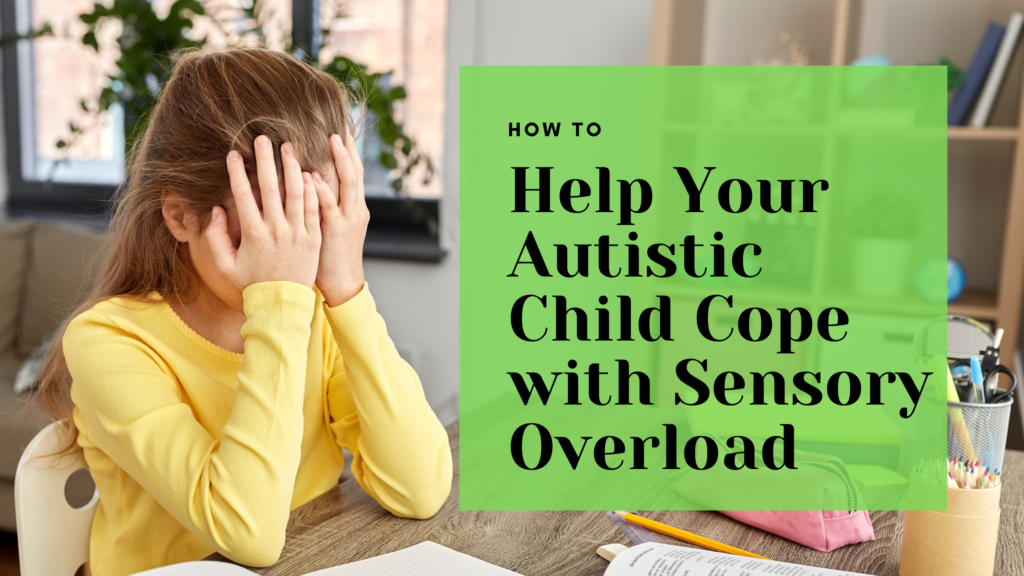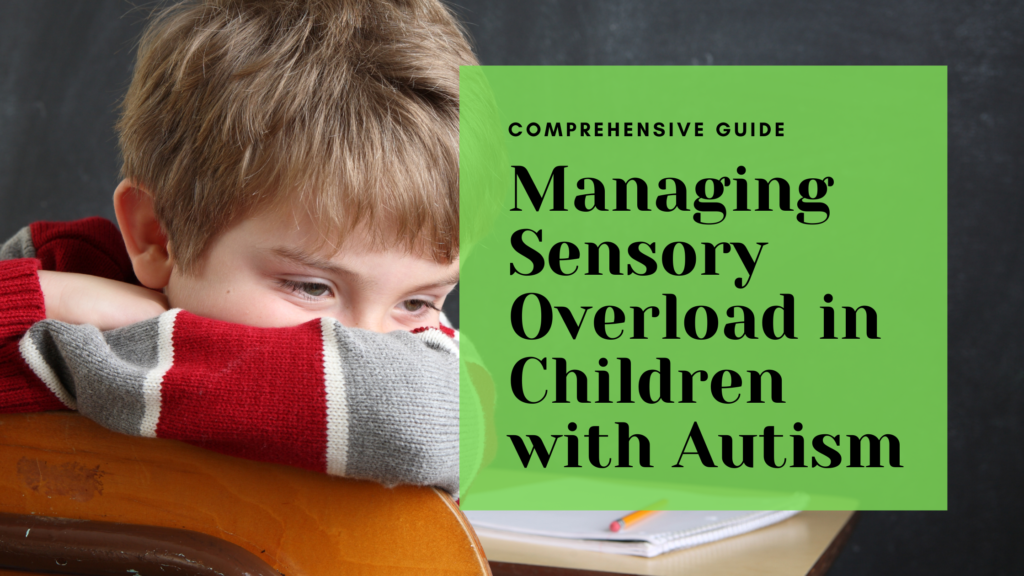I. Introduction
Sensory triggers are specific stimuli in the environment that can cause discomfort, anxiety, or even meltdowns in children with autism. These triggers may involve sounds, lights, textures, smells, or movements, and they often lead to sensory overload, making it difficult for children to function or focus.
Identifying sensory triggers is essential for improving the daily life of autistic children. By understanding what causes sensory overload, parents, teachers, and caregivers can help reduce anxiety, prevent meltdowns, and create a more comfortable environment. This article will cover common sensory triggers, methods to identify them, and strategies for creating an effective sensory management plan.
II. What Are Sensory Triggers in Autism?
Sensory triggers are stimuli that can cause an overwhelming response in children with autism. These triggers often relate to sensory processing issues, where the brain struggles to interpret and respond to sensory information correctly. When a child with autism encounters a sensory trigger, they may experience sensory overload—a condition where the brain becomes overwhelmed by too much information at once.
There are two main types of sensory responses related to triggers:
- Sensory hypersensitivity (over-responsiveness): Children who are hypersensitive may react strongly to sensory stimuli, such as loud noises or bright lights. Even small amounts of stimulation can cause discomfort.
- Sensory hyposensitivity (under-responsiveness): Children who are hyposensitive may not register certain stimuli, like soft sounds or gentle touches, and may seek out stronger sensations, like rough textures or fast movement.
III. Common Sensory Triggers for Children with Autism
Auditory Triggers
Many children with autism are sensitive to sound. Loud noises, such as alarms, sirens, or even background chatter in a classroom, can be overwhelming. Sudden or unexpected sounds, like the clanging of dishes, can also cause distress.
Visual Triggers
Bright or flashing lights, as well as visual clutter like too many objects in one space, can lead to sensory overload. Fast-moving visuals, such as people rushing by or screens with lots of movement, can be overstimulating for autistic children.
Tactile Triggers
Touch-related triggers are common in children with autism. Certain fabrics, such as wool or tags in clothing, may feel unbearable against the skin. Unplanned physical contact, like a hug or a pat on the back, can also be overwhelming for some children.
Olfactory (Smell) Triggers
Strong smells, such as perfumes, cleaning products, or certain foods, can be particularly challenging for children who are sensitive to odors. These smells may cause immediate discomfort or even nausea.
Gustatory (Taste) Triggers
Children with autism may have taste sensitivities, often resulting in picky eating habits. They may dislike certain food textures, flavors, or smells, making it difficult to eat a variety of foods.
Vestibular and Proprioceptive Triggers
The vestibular system controls balance and movement, while proprioception refers to body awareness. Children with vestibular triggers may feel discomfort during activities that involve balance, like swinging or spinning, while proprioceptive triggers may cause difficulty in understanding their body’s position in space.
IV. Signs of Sensory Overload in Children with Autism
When a child with autism experiences sensory overload, they may display certain behaviors. Meltdowns are a common sign of sensory overload. During a meltdown, a child may cry, scream, or become physically agitated because they feel overwhelmed.
Other signs include withdrawal, where the child shuts down, avoids interaction, or tries to escape the situation. They may also engage in stimming (self-stimulatory behaviors), such as rocking, flapping hands, or repeating certain motions, which can help them cope with the sensory overload.
Physical signs of sensory overload include:
- Covering ears to block out noise.
- Avoiding eye contact to reduce visual stimulation.
- Flinching or pulling away when touched unexpectedly.
Emotional reactions may include irritability, anxiety, or frustration, which can signal that the child is struggling with too much sensory input.
V. Methods for Identifying Sensory Triggers
Observation Techniques
The first step in identifying sensory triggers is careful observation. Pay attention to your child’s reactions in different environments, such as at home, school, or public places. Notice if they respond negatively to certain sounds, textures, or smells. Keep track of their body language, like covering their ears or avoiding eye contact, to pinpoint specific triggers.
Sensory Assessments
Sensory assessments, conducted by occupational therapists, can help identify sensory processing challenges. These assessments evaluate how your child responds to different sensory stimuli and can provide a clearer understanding of their sensory profile.
Keeping a Sensory Log
A sensory log is a helpful tool for tracking your child’s responses to various stimuli. Write down what triggers discomfort or meltdowns, noting the environment, time of day, and sensory input involved. Over time, patterns may emerge, making it easier to identify common triggers.
Collaboration with Professionals
Working with professionals, such as occupational therapists, teachers, or behavioral specialists, can provide valuable insights. These experts can observe your child in different settings and offer recommendations for managing sensory challenges.
Involving the Child
If your child is verbal, ask them what makes them uncomfortable. For non-verbal children, teach them to signal or indicate discomfort through gestures or visual aids. This communication helps involve the child in identifying their own sensory triggers.
VI. How to Create a Sensory Profile for Your Child
Assess Sensory Preferences and Avoidances
To create a sensory profile, start by identifying the sensory experiences your child enjoys and those they avoid. For example, does your child seek out spinning or jumping but dislike loud environments? This will give you a clear picture of their sensory preferences.
Track Patterns of Sensory Reactions
Using the sensory log, track patterns in your child’s responses. For example, if your child regularly reacts negatively to loud noises in crowded places, you can mark “auditory triggers” as a key issue. Understanding these patterns helps in developing better management strategies.
Create a Sensory Map
A sensory map is a tool that organizes your child’s sensory triggers into categories like auditory, visual, and tactile. This map can help caregivers and teachers understand which sensory inputs to avoid and which ones to encourage.
Use the Sensory Profile for Intervention Planning
Once you have a clear sensory profile, work with therapists or educators to develop personalized interventions. These might include strategies like adjusting the classroom environment or using sensory tools to help your child cope with specific triggers.
VII. Managing Sensory Triggers
Modify the Environment
One of the most effective ways to manage sensory triggers is to modify the environment. For instance, using noise-cancelling headphones can block out loud sounds, and adjusting the lighting can reduce visual overstimulation. At school, quiet corners or less cluttered spaces may help minimize sensory overload.
Create a Sensory-Friendly Routine
Establishing a predictable routine with built-in sensory breaks can help children self-regulate throughout the day. Sensory breaks give them time to unwind and recharge before returning to more stimulating activities.
Sensory Tools and Supports
There are many sensory tools available to help children manage their triggers. Weighted blankets can provide calming pressure, while fidget toys help with tactile stimulation. Calming visual aids like lava lamps or gentle lights can also reduce sensory overload.
Gradual Exposure to Triggers
For some children, gradual exposure to sensory triggers can increase their tolerance over time. This technique involves slowly introducing a trigger, such as a specific sound or texture, in a controlled way to help the child become more comfortable with it.
VIII. Working with Schools and Therapists to Address Sensory Triggers
Communicate Sensory Needs to School Staff
It’s essential to share your child’s sensory profile with their teachers and school staff. This ensures that the school environment is supportive and that sensory triggers are minimized.
Incorporate Sensory Breaks at School
Work with teachers to introduce sensory-friendly practices in the classroom. These may include quiet corners, sensory breaks, or allowing your child to use tools like noise-cancelling headphones during lessons.
Collaborate with Occupational Therapists
Occupational therapists can help children develop coping strategies for sensory overload. They can also suggest exercises and tools that are tailored to your child’s specific sensory needs.
Create a Sensory Plan
A sensory intervention plan outlines strategies to reduce sensory triggers and support the child’s sensory needs. This plan can include sensory breaks, environmental modifications, and specific tools to use during times of sensory overload.
IX. Adapting Over Time: Monitoring and Adjusting to Changing Sensory Needs
Regularly Review Sensory Triggers
Children’s sensory needs can change over time. It’s important to regularly reassess their sensory triggers and adjust the environment or tools they use accordingly.
Adapt Interventions as Needed
Be flexible in modifying sensory interventions. As your child grows, they may develop better coping strategies, or new triggers may emerge. Keep an open mind and adjust the sensory plan as needed.
Celebrate Progress
Celebrate your child’s progress in managing sensory triggers. Small improvements, such as learning to tolerate certain sounds or textures, are important milestones in their development.
X. Conclusion
Identifying sensory triggers is crucial for helping children with autism manage sensory overload and improve their daily functioning. By observing sensory responses, creating a detailed sensory profile, and working with professionals, parents and caregivers can develop effective strategies to reduce anxiety and prevent meltdowns. Stay engaged in the process and continue collaborating with therapists and educators to support your child’s sensory needs, ensuring they feel comfortable and confident in all aspects of life.
Here’s a table with 10 key points based on the article:
| # | Key Point | Description |
|---|---|---|
| 1 | Understand Sensory Processing Differences | Recognize that autistic children may experience sensory hypersensitivity or hyposensitivity, leading to different sensory triggers. |
| 2 | Identify Common Sensory Triggers | Be aware of common sensory triggers like loud noises, bright lights, certain textures, strong smells, and crowded spaces. |
| 3 | Observe Your Child’s Behavior | Regular observation in different environments (home, school, public spaces) helps identify patterns and specific triggers. |
| 4 | Keep a Sensory Log | Record details of your child’s reactions to sensory stimuli in a log, including the time, place, and type of trigger, to track patterns. |
| 5 | Work with Occupational Therapists | Collaborate with professionals to conduct sensory assessments and identify the child’s sensory triggers using structured evaluations. |
| 6 | Pay Attention to Physical and Emotional Signs | Watch for physical signs (covering ears, avoiding eye contact) and emotional reactions (anxiety, frustration) that indicate sensory overload. |
| 7 | Involve the Child in Identifying Triggers | For verbal children, ask them directly what makes them uncomfortable. For non-verbal children, teach them to signal sensory discomfort. |
| 8 | Create a Sensory Profile | Develop a sensory profile that maps out your child’s sensitivities and preferences to help guide sensory-friendly strategies. |
| 9 | Modify the Environment to Reduce Sensory Overload | Adjust the child’s surroundings by reducing noise, using calming lighting, and offering sensory tools to help manage triggers. |
| 10 | Review and Adjust Over Time | Sensory needs can change, so regularly review sensory triggers and adjust strategies as the child develops new coping mechanisms. |
This table outlines key tips to consider when identifying sensory triggers in children with autism, providing practical guidance for managing sensory overload.


